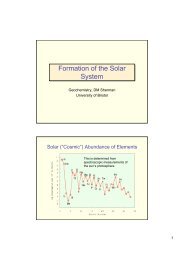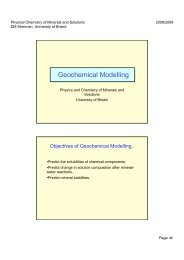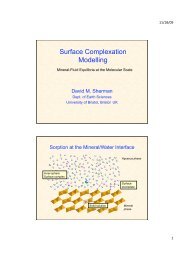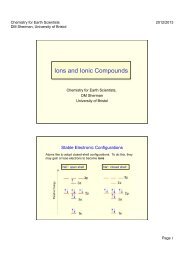Soil and Groundwater Equilibria - Aqueous and Environmental ...
Soil and Groundwater Equilibria - Aqueous and Environmental ...
Soil and Groundwater Equilibria - Aqueous and Environmental ...
You also want an ePaper? Increase the reach of your titles
YUMPU automatically turns print PDFs into web optimized ePapers that Google loves.
<strong>Environmental</strong> Geochemistry<br />
DM Sherman, University of Bristol<br />
Practical 3: Solubility, Sorption <strong>and</strong> Ion Exchange <strong>Equilibria</strong> Applied to <strong>Soil</strong><br />
<strong>and</strong> <strong>Groundwater</strong><br />
The goal of this practical is to use solubility <strong>and</strong> surface complexation<br />
calculations to predict the aqueous concentrations of a toxic metal (Pb) in water<br />
equilibrated with a contaminated soil. As with earlier practicals, the strategy you<br />
should use is to write out the equilibrium expressions <strong>and</strong> take the p-function of<br />
both sides to get a set of simple linear equations that you can solve.<br />
1. A soil contains 50 ppm Pb (Atomic mass = 207.2) as PbSO 4 (anglesite). The<br />
porosity of the soil is 15 % <strong>and</strong> the density of the soil is 2.65 g/cm 3 . For the<br />
problems below, use the table of equilibrium constants:<br />
Reaction<br />
pK<br />
PbSO 4 = Pb 2+ + SO -2 4<br />
7.8<br />
PbCO 3 = Pb 2+ + CO -2 3<br />
13.1<br />
CaSO 4 = Ca 2+ + SO -2 4<br />
4.4<br />
CaCO 3 = Ca 2+ + CO -2 3<br />
8.5<br />
HCO - 3 = H + + CO -2 3<br />
10.33<br />
CO 2 + H 2 O = H 2 CO 3 1.46<br />
H 2 CO 3 = H + + HCO -2 3<br />
6.35<br />
(a) Calculate the concentration of Pb in a solution that saturates the solution in<br />
pore space of the soil. Assume that only anglesite is present. Does the<br />
amount of anglesite in the soil matter? Assume charge balance requires<br />
[Pb 2+ ] = [SO 4 -2 ].<br />
(b) Now assume that the soil also contains 1 wt. % CaSO 4 (anhydrite). What<br />
does the charge balance condition require? Does the amount of anhydrite<br />
matter? Calculate the concentration of Pb in the porewater.<br />
(c) Now assume that the soil also contains 1 wt % CaCO 3 . Will PbSO 4 dissolve<br />
to precipitate PbCO 3 ? Calculate the solubility of Pb if the pH of the soil is 8 <strong>and</strong><br />
is in equilbrium with the atmosphere so that P CO2 = 10 -3.5
<strong>Environmental</strong> Geochemistry<br />
DM Sherman, University of Bristol<br />
(d) Now include the effect of sorption on FeOOH (5 wt. %) in the soil at pH 8.<br />
The surface area of the FeOOH is 30 m 2 /g <strong>and</strong> there are 3 >FeOH sites/nm 2 .<br />
(note: >FeOH means a surface site). Relevant equilbria are<br />
Reaction<br />
pK<br />
>FeOH + H+ = >FeOH 2 + -9.2<br />
>FeOH + Pb +2 = >FeOHPb +2 -4.65<br />
First, calculate the maximum sorption capacity of the goethite. Then assume, as<br />
a first approximation, that essentially all of the Pb sorbs to the goethite to get a<br />
value for {>FeOHPb +2 }. Now, calculate the resulting concentration of dissolved<br />
Pb that would be in equilbrium with a goethite with that value of {>FeOHPb +2 }.<br />
Note that you have {>FeOH}/{>FeOH 2 + } = 10 -pKa 10 -pH <strong>and</strong> also {>FeOH} +<br />
{>FeOH 2 + } + {>FeOHPb} = 1.<br />
e) If you underst<strong>and</strong> all this, do it again for the soil at pH = 6.<br />
2. Water from the Bath Hot Springs (pH = 6.65) has the following chemical<br />
analysis:<br />
mol/kg<br />
HCO - 3 3.147 x 10 -3<br />
Ba 1.75 x 10 -7<br />
Ca 9.52 x 10 -3<br />
Cl 8.09 x 10 -3<br />
Fe +2 1.77 x 10 -5<br />
K 4.45 x 10 -4<br />
Mg 2.18 x 10 -3<br />
Mn 1.24 x 10 -6<br />
Na 7.96 x 10 -3<br />
SO 4 1.08 x 10 -2<br />
Si 3.43 x 10 -4<br />
Sr 6.73 x 10 -5<br />
pC<br />
What minerals has this water equilibrated with? To find out, calculate the<br />
saturation index (log (Q/K) = pK-pQ) of each c<strong>and</strong>idate mineral. The quantity Q<br />
is the observed “ion activity product” of a mineral. For example, the Q for KCl<br />
(sylvite) in the above analysis is [K][Cl] = (4.45x10 -4 )(8.09x10 -3 )= 3.6 x10 -6 . You<br />
need the following equilibria:<br />
Equilibrium pK pQ<br />
CaCO 3 = Ca 2+ + CO -2 3<br />
8.48<br />
CO - 3 + H+ = HCO - 3<br />
-10.33<br />
MgSO 4 .7H 2 O = Mg 2+ + SO -2 4 + 7H 2 O 1.96
<strong>Environmental</strong> Geochemistry<br />
DM Sherman, University of Bristol<br />
BaSO 4 = Ba +2 + SO -2 4<br />
9.98<br />
CaSO 4 -2H 2 O = Ca2+ + SO -2 4 + 2H 2 O 4.85<br />
SiO 2 (quartz) + 2H 2 O = H 4 SiO 4 4.0<br />
SiO 2 (amorphous) + 2H 2 O = H 4 SiO 4 3.0<br />
FeCO 3 = Fe 2+ + CO -2 3<br />
10.6<br />
Mg 2 Si 3 O 7 .5OH:3H 2 O (sepiolite) + 0.5H 2 O + -15.91<br />
4H+ = 2Mg +2 + 3H 4 SiO 4<br />
CaMg(CO 3 ) 2 (dolomite) = Ca +2 + Mg +2 + 17.0<br />
2CO -2 3<br />
When the saturation index > 0, (pQ < pK) then the mineral will want to precipitate<br />
out; when SI = 0 (pQ = pK) the solution is in equilibrium with that mineral; when<br />
SI < 0 (pQ > pK), the mineral will dissolve in the solution. Because of analytical<br />
error <strong>and</strong> kinetics, you can assume that if pQ = pK +/- 0.4 then the solution is<br />
saturated in that mineral. Assume now that all of the iron oxidizes when reaching<br />
the surface. Will Fe(OH) 3 precipitate out <strong>and</strong> make a rusty mess at Bath Spa?<br />
You need the following equilibria: (Hint: work out the dominant Fe dissolved<br />
complex (e.g. Fe 3+ , Fe(OH) 2<br />
+ or Fe(OH) 3<br />
0 at pH 6.65 <strong>and</strong> the equilibrium<br />
expression for Fe(OH) 3 (ferrihydrite) dissolving to give that complex.<br />
Fe(OH) 3 (ferrihydrite) + 3H+ = Fe +3 + 3H 2 O -4.9<br />
Fe +3 + 2H 2 O = Fe(OH) + 2 + 2H+ 5.7<br />
Fe +3 + 3H 2 O = Fe(OH) 0 3 + 3H+ 13.6<br />
3. Consider the ion exchange reaction<br />
with<br />
Ca 2+ + Na2-Clay = Ca-Clay + 2Na +<br />
K s<br />
= N Ca [Na]2<br />
N 2 Na<br />
[Ca]<br />
= 2.35<br />
€<br />
a) Calculate the equivalent fraction of exchange sites occupied by Ca if [Na] =<br />
0.1 M <strong>and</strong> [Ca] = 0.1 M assuming activities = concentrations.<br />
b) Do the same as in a) but when the soil solution is diluted by a factor of 100.<br />
What is the effect of dilution on the Na content of the clay?
<strong>Environmental</strong> Geochemistry<br />
DM Sherman, University of Bristol<br />
4. Consider the uptake of Cs+ by a Ca +2 clay: In terms of Cation Exchange<br />
capacity (CEC), we can write:<br />
N Cs<br />
= M Cs<br />
CEC ; N Ca<br />
= M Ca<br />
/ 2<br />
CEC = CEC − M Cs<br />
CEC<br />
where M Cs is the number of mmoles of Cs per kg/clay<br />
€<br />
K s<br />
= (M / Cs CEC)2 [Ca 2+ ]<br />
= 2.35<br />
⎛ CEC − M ⎞<br />
⎜<br />
Cs<br />
⎟ [Cs + ] 2<br />
⎝ CEC ⎠<br />
Supposing € at clay had a cation exchange capacity of 200 mmoles/kg. Calculate<br />
the Kd for Cs between clay <strong>and</strong> the soil solution with [Ca] = 0.001 <strong>and</strong> [Cs] =<br />
0.001 M. What assumptions have to be made before you can use this Kd in a<br />
contaminant-transport model?
















